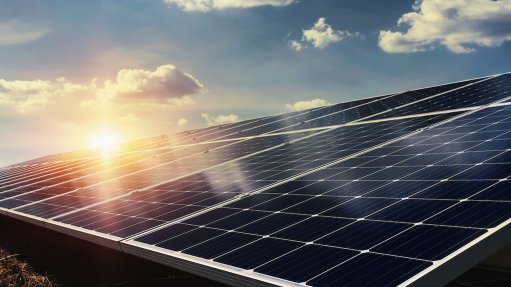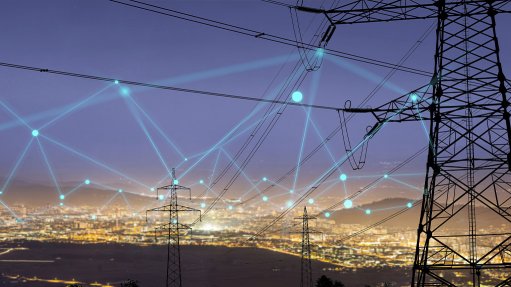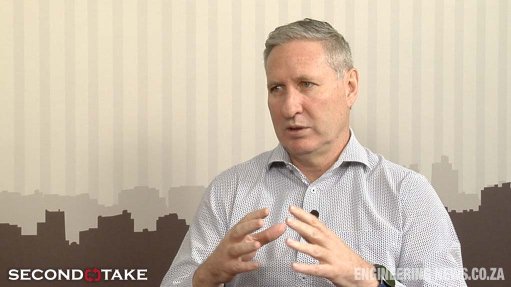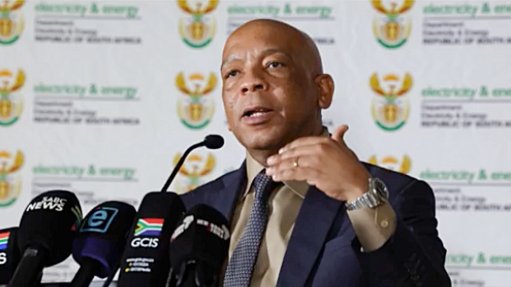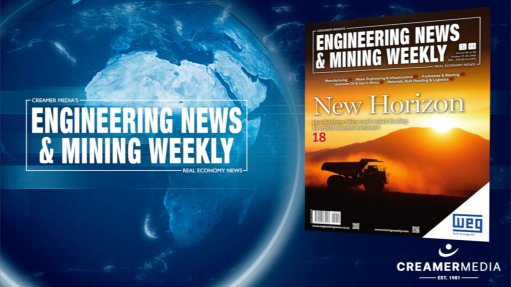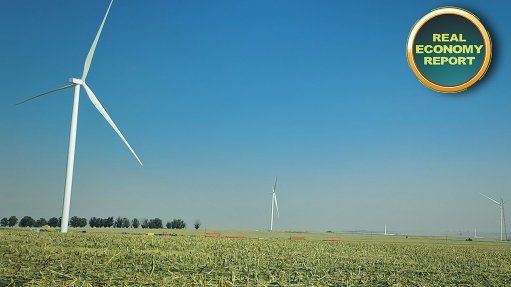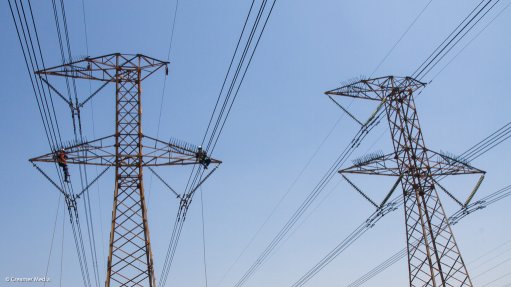Green energy presenting South Africa with massive reindustrialisation chance – Nedbank

Green Hydrogen Roundtable covered by Mining Weekly's Martin Creamer. Video: Creamer Media's Shadwyn Dickinson.
Green electrons and green molecules are presenting South Africa with a massive opportunity to reindustrialise, Nedbank CIB head of infrastructure, energy and telecommunications Mike Peo told the Green Hydrogen Roundtable this month.
“We have an opportunity for South Africa to completely reindustrialise, to start building up our industrial base that we have lost over the last ten to 15 years,” was Peo’s inviting message at the event addressed by Chemical Industries Education and Training Authority (CHIETA) CEO Yershen Pillay, as well as by Higher Education and Training Department deputy director- general Zukile Mvalo.
A construct described as being critical is the need for the proper, holistic understanding of the pioneering solutions for renewable energy and how these give rise to the rewarding opportunity to create employment across a broad front.
The outlook comes against the far- reaching current generation of renewable solar and wind energy and the big volumes of renewable-energy generation planned, which provides scope for the generation of green molecules in addition to green electrons.
On the widespread opportunity presented by the generation of green molecules, Peo drew attention to what he described as “a massive misunderstanding of what green hydrogen represents”.
“Huge numbers of people think that green hydrogen is one particular thing. The view held by many is that green hydrogen is going to be manufactured and used as a fuel source. We’ll convert electrons into molecules and do something with those molecules.
“But the reality is that there’s an incredible ecosystem that exists around green hydrogen. There are maybe 30 to 40 very specific types of opportunity that can arise as a consequence of building green hydrogen and green ammonia production plants and having molecules that can be utilised.
“The very obvious ones are the platinum group metals, building batteries, hydrogen fuel cells, very obvious. We have a massive mining sector.
“We can build green fuel cells to power some of the massive pieces of mining equipment that we need.
“We have a very dirty rail system. We can clean that up with green hydrogen trains, for example. We have a massive transport logistics industry, we need different battery sources to power those trucks.
“Sasol has manufactured its synfuels at Secunda for the past 30, 40 years. Between Sasol and Eskom, South Africa contributes something like 80% of the entire African continent’s carbon emissions.
“The ability to clean up those two entities lets the rest of the continent off the hook. We can fundamentally fix the emissions problem in helping those other countries get to their net-zero targets just by fixing Sasol and Eskom.
“The green ammonia/green hydrogen ecosystem ultimately enables Sasol to transform itself. The Eskom story is a little bit more complicated. Eskom has got to decommission old coal-fired power stations but some of those power stations can be transitioned via, initially, gas, and, ultimately, using green hydrogen as a fuel source. There is complexity in all of those things.
“When I said a lot of people see green hydrogen as a single thing, the real passionate belief that I have is that we have an opportunity for South Africa to completely reindustrialise, to start building up our industrial base that we have lost over the last ten to 15 years. There is a new opportunity.”
Failure to do so will also put South Africa at a huge disadvantage.
“If we, for example, do not clean up our transport industry systems, our cold storage systems, we get to a point where in five years’ time, we can no longer export fruit and vegetable products to our biggest partners in Europe because of the Carbon Border Adjustment Mechanism where the Europeans are going to tax us if we want to bring non- renewable sourced product into their countries.
“The same thing happens with South African car manufacture. The motor vehicles we produce are being largely exported. It is not enough that we are going to be producing electric vehicles. We’ve got to produce green electric vehicles, we need green steel. So, there are a number of opportunities that do exist and if we can start to get the momentum going, we really are very well positioned to actually make that happen.
“What I really believe is that we need one massive catalytic project. We have one; it’s called the Hive Green Ammonia Project at Coega, in the Eastern Cape. If that project can go ahead, it’s a $5-billion initial piece of investment but it’s perfectly positioned,
“It has desalinated water, it has potentially the green electrons that are needed to power up the plant, and it can be the catalytic piece of the creation of a green hydrogen valley, where all infrastructure is concentrated in one area so that everybody who has a desire to play in this ecosystem can come and start to operate there.
“The principle is to have shared infrastructure, so instead of building plants in five different locations around the country, where in each instance they are going to have to bring in the water infrastructure, try to create hubs almost like industrial development zones.
“Funding has been provided for a pilot project for the Eastern Cape, which is under way at the moment. It is being done in collaboration with some of the universities and the training colleges, so the momentum is being built, the skills are being developed so that when the project is ready to go, there is a well-trained employment base in that part of the world.
Green hydrogen has profound economic and social implications, including job creation, skills development, and the fostering of new industries.
“In this regard, I am proud to inform you that Minister [Blade] Nzimande launched several Labour Market Intelligence reports last month at the Council for Scientific and Industrial Research on the Skills Needs for the Economy and the Identification of Skills Needed for the Hydrogen Economy. One focused on the hydrogen sector, underscoring its critical importance to the economy and job creation,” Mvalo told the roundtable covered by Engineering News & Mining Weekly.
“South Africa is exploring the potential for green hydrogen as an energy source that can meet the country’s net-zero ambitions and stimulate economic growth. The research has predicted that South Africa will deploy at least 15 GW of electrolysis to produce 500 kilotonnes of green hydrogen annually for use in the transportation, built environment, industrial, and power sectors, creating approximately 30 000 jobs by 2040.
“It indicates that we have our work cut out for ourselves, particularly CHIETA, as the report maps out the skills supply and demand in the hydrogen economy,” Myalo said.
Article Enquiry
Email Article
Save Article
To advertise email advertising@creamermedia.co.za or click here
Comments
Press Office
Announcements
What's On
Subscribe to improve your user experience...
Option 1 (equivalent of R125 a month):
Receive a weekly copy of Creamer Media's Engineering News & Mining Weekly magazine
(print copy for those in South Africa and e-magazine for those outside of South Africa)
Receive daily email newsletters
Access to full search results
Access archive of magazine back copies
Access to Projects in Progress
Access to ONE Research Report of your choice in PDF format
Option 2 (equivalent of R375 a month):
All benefits from Option 1
PLUS
Access to Creamer Media's Research Channel Africa for ALL Research Reports, in PDF format, on various industrial and mining sectors
including Electricity; Water; Energy Transition; Hydrogen; Roads, Rail and Ports; Coal; Gold; Platinum; Battery Metals; etc.
Already a subscriber?
Forgotten your password?
Receive weekly copy of Creamer Media's Engineering News & Mining Weekly magazine (print copy for those in South Africa and e-magazine for those outside of South Africa)
➕
Recieve daily email newsletters
➕
Access to full search results
➕
Access archive of magazine back copies
➕
Access to Projects in Progress
➕
Access to ONE Research Report of your choice in PDF format
RESEARCH CHANNEL AFRICA
R4500 (equivalent of R375 a month)
SUBSCRIBEAll benefits from Option 1
➕
Access to Creamer Media's Research Channel Africa for ALL Research Reports on various industrial and mining sectors, in PDF format, including on:
Electricity
➕
Water
➕
Energy Transition
➕
Hydrogen
➕
Roads, Rail and Ports
➕
Coal
➕
Gold
➕
Platinum
➕
Battery Metals
➕
etc.
Receive all benefits from Option 1 or Option 2 delivered to numerous people at your company
➕
Multiple User names and Passwords for simultaneous log-ins
➕
Intranet integration access to all in your organisation








